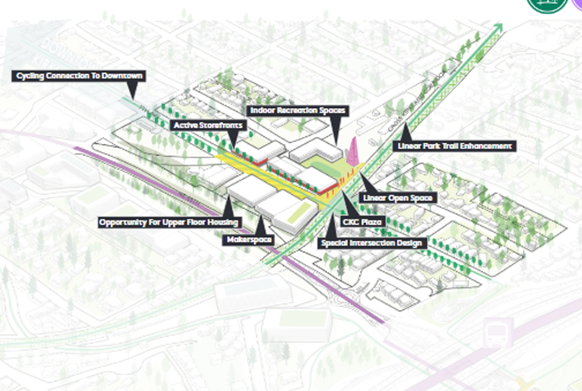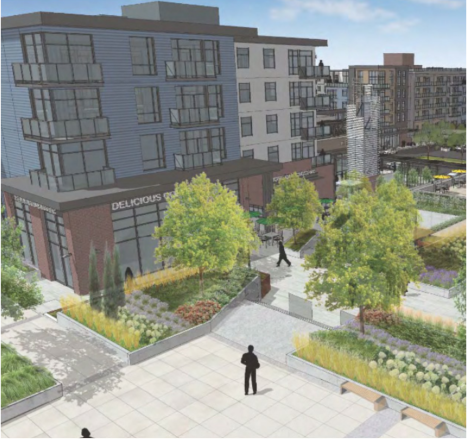11. URBAN DESIGN FRAMEWORK
The urban design framework establishes a set of overarching goals, policies, and strategies to shape future public and private development and investments in the district. The Station Area Design District is divided into four urban design subdistricts. While the design of public and private development will be guided in a manner that creates a cohesive identity for the Station Area, each subdistrict will evolve into its own unique neighborhood character and identity, described in more detail below (see Figure 13).
There is a mutually supportive relationship between transit ridership and the amount of housing, jobs, and services near transit. The Station Area Plan designates the areas closest to the future BRT Stride station as priority locations for increased development. Not only are these areas prime opportunities to broaden the mix of jobs and housing choices within the Station Area, but this strategy also focuses growth in a more sustainable, compact form. In addition, the areas closest to the future station on the east side of I-405 are reserved for taller office development. This serves a dual role of focusing growth in the City where residents and employees have the best access to high-capacity transit for the station and using larger office buildings as a buffer to protect residences from the noise and air pollution that come from high volume roadways like I-405.
The vision for the Station Area includes a robust, vibrant public realm with a mix of active ground floor uses, generous sidewalks, and improved tree canopy. The urban design framework identifies key streets where a combination of public and private investments will create focal points and destinations for the district, the city, and the region. These include enhancing NE 85th Street to a more urban street that becomes a place for people to engage, supporting retail-focused streets like 120th Avenue NE near Forbes Lake, and neighborhood hubs like the 7th Avenue corridor in Norkirk. Each of these focal points brings together recommendations around mobility, public realm, land use, sustainability, and building massing.

Figure 13: Public Realm “Spine”
As a Station Area Plan, it is particularly important to create a network of mobility options that connect transit users to the station and key services and destinations. Green midblock connections help break down large blocks into walkable distances. New and enhanced sidewalks and bikeways provide safe and comfortable walking and biking connections throughout the district. Finally, increased transit service, including the Stride BRT station and future King County Metro’s K-line BRT, flexible parking policies, and strategic roadway capacity improvements provide a multi-faceted approach to mitigate congestion and accommodate travel needs and parking demand. This holistic approach to mobility is integrated into all aspects of the urban design framework.
Like all of Kirkland, the Station Area is a rich natural environment with important ecological assets and opportunities to improve the sustainability and resilience of the district. Updated policies encourage stormwater management through on-site green infrastructure like bioswales in streetscapes and within larger developments. Street types in the Form-Based Code will lead to increased tree canopy in the public realm, and ecological assets like Forbes Lake become the focus of a new boardwalk network and “trailhead” that is integrated into the streetscape at 120th Avenue NE and NE 90th Street.
While planning for growth in the station area, supporting transitions in scale to adjacent neighborhoods is a key focus of the urban design framework. The Form-Based Code regulates elements of massing and form so that buildings step down from larger commercial office blocks to mid-rise neighborhood mixed use development, and eventually to smaller “missing middle” infill. Special rules for transitions, landscaping requirements, and other policies further specify how new development should respond to the existing context. Additional design guidelines and the City’s Design Review process will ensure that building massing and details reflect a pedestrian-oriented district.
Urban Design Subdistricts
The Station Area Design District is divided into four urban design subdistricts. While the design of public and private development will be guided in a manner that creates a cohesive identity for the Station Area, each subdistrict will evolve into its own unique neighborhood character and identity, described in more detail below. The Station Area Design Guidelines will provide detailed guidelines for development and will be used by the Design Review Board to evaluate proposed development as part of the Design Review Process.
Figure 14: Urban Design Subdistricts
Norkirk Maker District
The Norkirk Maker District creates new opportunities for local businesses and mixed use. The existing character of industrial buildings and small businesses can evolve over time to maintain this industrial character while encouraging more pedestrian oriented, innovation-focused development. “Maker spaces,” small scale manufacturing, and local businesses will all serve to activate the corridor and create a neighborhood hub to serve Norkirk and Highlands residents and workers. Limited residential infill will also provide opportunities for meeting Kirkland’s need for diverse housing choices. Alongside these development opportunities, facilities such as climbing walls, gyms, and other indoor recreation uses can meet community needs and provide amenities for visitors.
Norkirk’s light industrial technology (LIT) area is an important future bike and pedestrian corridor connecting Downtown Kirkland, the CKC and the BRT Stride station. New mobility connections provide space for enhanced urban landscaping, improve accessibility to existing parks, and connect the entire Subarea. Activating the intersection of the Cross Kirkland Corridor and 7th Avenue can create both a gateway and a neighborhood gathering place with multimodal and recreational amenities. Businesses can be integrated with activation of the Cross Kirkland Corridor (CKC). 
Figure 15: Maker District Concept
Green Innovation District
The Innovation District is a model of innovation and a place for community, students, and the workforce to connect. New residents will contribute to existing needs for additional school capacity in Kirkland. Innovative models for schools can be developed by adding significant development capacity on existing Lake Washington School District properties and integrating educational space with other uses in multi-story, mixed-use buildings or within campus-like developments.
There are opportunities to align educational and workforce development initiatives, supporting both large and small businesses, a green economy, and offering a range of job choices. Mixed-use educational spaces can be included within the new civic mixed use regulating district as part of the new Form-Based Code, in private mixed-use developments as part of zoning that facilitates educational uses within active streetscapes, and through an incentive zoning program or within the new civic mixed-use regulating district as part of the new Form-Based Code. The Form-Based Code will include educational facilities, including childcare and pre-K spaces, in allowances for ground floor uses.
Figure 16: Green Innovation District Concept
Downtown Gateway District
The Gateway district to Downtown Kirkland via 6th Street emphasizes mid-rise residential and office uses along 6th Street and important bicycle and pedestrian connections along green pathways to and from the BRT Stride station and the Cross Kirkland Corridor. These connections also improve mobility between existing and planned employment centers.

Figure 17: District Context on 6th Street
Rose Hill Gateway District
The Rose Hill corridor-based gateway will contain a mix of active ground floors and mid-rise residential uses along NE 85th that focus on creating a strong sense of arrival from Redmond with streetscape design, public art, and urban design features. This district, with its increased development allowances, will also provide the greatest opportunity to accommodate affordable housing.
Figure 18: Plaza and Gateway Concept at 85th/122nd
Urban Design Goals and Policies
Goal SA-83:
Focus growth in inclusive housing and jobs near transit with comprehensive design standards that ensure an attractive, sustainable, and integrated public and private realm.
Policy SA-84:
Establish a strong public realm network and transit-oriented community that puts people first and integrates public streetscape and open space improvements with building and site design standards.
Policy SA-85:
Use urban design to create a multi-modal transportation network that connects residents, workers, and visitors, and mitigates physical barriers.
Policy SA-86:
Leverage existing natural systems and resources, enhance ecosystem performance, and increase resilience through innovative development standards.
Policy SA-87:
Ensure appropriate development scale with transitions to adjacent neighborhoods through clear transition requirements and contextual design standards.


